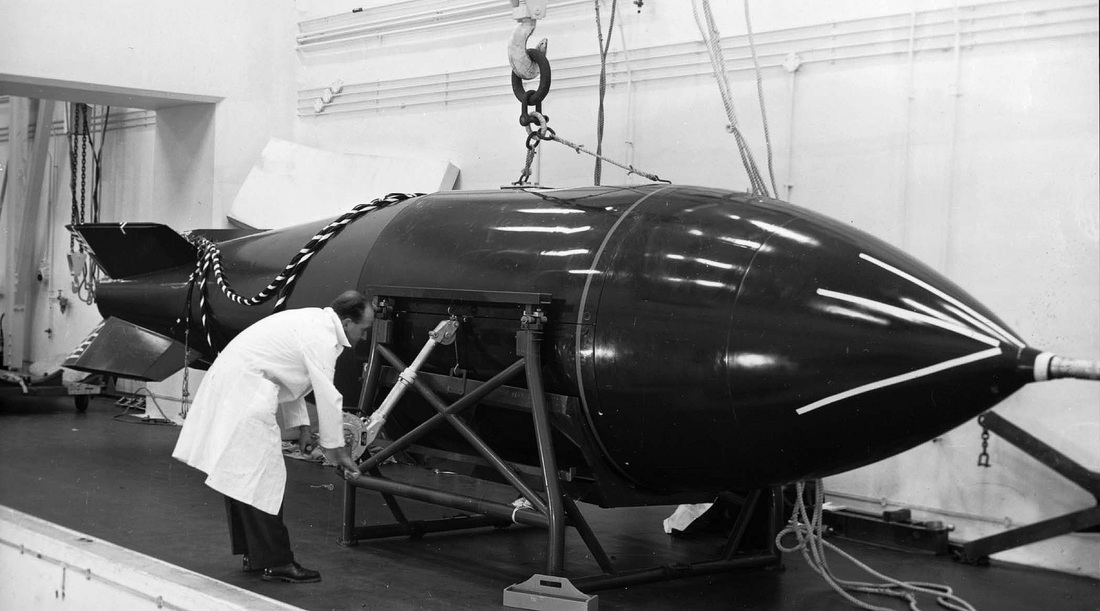Picture HM1 © Sam Tolley. Looking from inside the Danger Area towards the main access point. A plutonium core storage building, locally known as an 'igloo', is in the foreground.
What was raf barnham nuclear WEAPON storage site?
Barnham Nuclear Storage Site (NSS) was active during the early part of the Cold War and was one of only two such facilities built in the UK to store the BLUE DANUBE free fall nuclear bomb. The nuclear storage site was built during the mid 1950s to maintain the BLUE DANUBE away from the V-Bomber bases as well as holding the 'second strike' stock should nuclear war break out. The other site was at RAF Faldingworth in Lincolnshire, which is also partially detailed on this site.
On official records, Barnham Nuclear Weapon Storage Site was known as a "Special Storage Site" and to those that worked there it was "Top Site", in relation to the domestic site on the Thetford-Bury St Edmunds Road.
Barnham served the 'southern' V-Force bomber airfields, occupied by No 94 Maintenance Unit (MU), with Faldingworth's 92 MU covering the 'northern' bases. Barnham went on to store the RED BEARD nuclear weapon which succeeded BLUE DANUBE.
Ultimately, the depot had a relatively short life span, ceasing to be capable of holding nuclear weapons in the Summer 1963.
On official records, Barnham Nuclear Weapon Storage Site was known as a "Special Storage Site" and to those that worked there it was "Top Site", in relation to the domestic site on the Thetford-Bury St Edmunds Road.
Barnham served the 'southern' V-Force bomber airfields, occupied by No 94 Maintenance Unit (MU), with Faldingworth's 92 MU covering the 'northern' bases. Barnham went on to store the RED BEARD nuclear weapon which succeeded BLUE DANUBE.
Ultimately, the depot had a relatively short life span, ceasing to be capable of holding nuclear weapons in the Summer 1963.
|
Picture HM2 (© Crown Copyright). The site, probably in its early operational period, if not during the latter stages of construction. The site is clear of foliage providing good security vantages from the watch towers. You can see on the image opposite that a very distinct line still exists where the outer fence/barbed wire used to be and how the perimeter walls and fencing had been modified. Some of the buildings on the approach road and in the 'Danger Area' are yet to be constructed.
|
Picture HM3 (Unknown Originator). An aerial image of the site in its more recent form, densely populated by trees and with one of the explosives storage buildings missing following fire and subsequent demolition in the 1980s. Since this image, the site has been heavily de-forested to bring back some resemblance of how it looked in its operational days; some trees remain for wildlife preservation reasons.
Picture HM4 (© Crown Copyright). A BLUE DANUBE Freefall Nuclear Bomb
|
The AIMS OF THE WEBSITE
I have two intentions for this website. Firstly, I wish to gain the attention of personnel who have working knowledge of this storage site from its operational period from the mid-1950s until the mid 1960s, with the hope they can add more to it. Secondly, I hope for it to become a good archive of what went on here for future generations to make use of.
I have included pictures and descriptions of what I believe to be true about Barnham's Top Site. I have also tried to include accounts from personnel who worked there, trying to build a common picture where possible. As more information becomes available this site will change to incorporate that detail.
Analysis of the site and how it operated have been derived from internet sources as well as from accounts of former personnel who worked on the site during its operational period. If there are any inaccuracies or omissions, please get in touch. I have put a
comments function at the bottom of each picture page and on the "contact" tab. My list of contributors can also be found on the tabs above.
As a footnote, English Heritage produced a report on the site in 2011 which makes for interesting further reading, utilising the The National Archives Public Records Office. It is entitled 'Research Department Report Series No 48 2011 ISSN1749-8771' and can be found online.
I hope if you're still reading that you're interested and enjoy the pictures and information I've compiled here.
Thanks for looking,
SJT
I have included pictures and descriptions of what I believe to be true about Barnham's Top Site. I have also tried to include accounts from personnel who worked there, trying to build a common picture where possible. As more information becomes available this site will change to incorporate that detail.
Analysis of the site and how it operated have been derived from internet sources as well as from accounts of former personnel who worked on the site during its operational period. If there are any inaccuracies or omissions, please get in touch. I have put a
comments function at the bottom of each picture page and on the "contact" tab. My list of contributors can also be found on the tabs above.
As a footnote, English Heritage produced a report on the site in 2011 which makes for interesting further reading, utilising the The National Archives Public Records Office. It is entitled 'Research Department Report Series No 48 2011 ISSN1749-8771' and can be found online.
I hope if you're still reading that you're interested and enjoy the pictures and information I've compiled here.
Thanks for looking,
SJT
No copyright infringement is intended for any material I use on this site and where known I will put the originator's details. Nothing on here is for financial gain and is purely research orientated. If you believe any of the material on here is yours and you wish to have it removed or accredited to you, please get in touch via the "CONTACTS" page to rectify.




